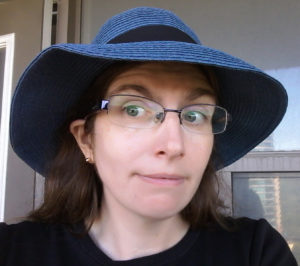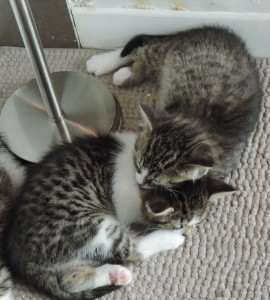 Ada Hoffmann is the author of Monsters in My Mind
Ada Hoffmann is the author of Monsters in My Mind . She has published over 60 speculative short stories and poems in magazines such as Strange Horizons, Asimov’s, and Uncanny. She is a winner of the Friends of the Merrill Collection Short Story Contest and a two-time Rhysling award nominee.
. She has published over 60 speculative short stories and poems in magazines such as Strange Horizons, Asimov’s, and Uncanny. She is a winner of the Friends of the Merrill Collection Short Story Contest and a two-time Rhysling award nominee.
Ada was diagnosed with Asperger syndrome at the age of 13. Her Autistic Book Party review series is devoted to in-depth discussions of autism representation in speculative fiction. You can find her online at http://ada-hoffmann.com/ or on Twitter at @xasymptote
Is there a literary heroine on whom you imprinted as a child? A first love, a person you wanted to become as an adult, a heroic girl or woman you pretended to be on the playground at recess? Who was she?
My parents were careful to keep me supplied with brave, plucky, intelligent female role models as a child – The Paper Bag Princess, Princess Leia Organa, Princess Eilonwy, Lucy Pevensie, Ariel, Nala, Hermione Granger. It was the 90s, and even the Disney princesses were plucky. The woman who comes to mind most, though, was a real woman – the astronaut Julie Payette.
Julie Payette is an engineer, a pilot, a robotics specialist, and was the second Canadian woman in space. This year, she was appointed Canada’s Governor General. It’s a good year for Canadian women who want to go to space.
It’s hard to explain what space meant to me as a small child. There are forms of romanticism that don’t survive adolescence unaltered. There is something wonderful about the idea of blasting off into the unknown, going where no human has gone before. But it was simpler and deeper than that. I grew up on science fiction and fantasy, a literature of infinite possibilies. I knew that Narnia and Tatooine and Middle-Earth weren’t real – but space was. And without space the way I imagined it as a child, without its infinite array of strange new worlds, the Earth simply felt too small.
Can you remember what it was these characters did or what qualities they had that captured your affections and your imagination so strongly?
When I was five or six years old, I told a boy at school that I wanted to be an astronaut. He said, “You can’t do that, you’re a girl.” My parents rebutted that argument by showering me with books about women astronauts – people like Sally Ride and Roberta Bondar. (I don’t remember having a book about Valentina Tereshkova, but I certainly knew of her as well.) They took me to public talks at the local university, one by Bondar, another by Payette.
Both women caught my attention, but Payette was the one who captured my imagination. Bondar had already retired and become an environmentalist. I liked environmentalism just fine, but I knew she was never going back into space. Julie Payette’s space adventures were, at the time, still in front of her.
I must have stuck out, an eight-year-old child in a sea of college students, but I don’t remember feeling self-conscious. I do remember the signed picture of Julie Payette that my dad got for me, with my name on it. “Ad Astra!” it said. That picture stayed on my bedroom wall right up until I moved out.
How does she compare to the female characters in your work? Is she their literary ancestor? Do they rebel against all she stands for? What might your creations owe her?
My female characters are really not much like Julie Payette, and it’s because of what happened after I was a child.
In junior high school, I stopped wanting to go to space. I was old enough to understand that modern space travel – cramped, crowded, physically and mentally grueling, and stuck in Earth orbit – was not what I’d thought. I was also old enough to know I could never be an astronaut. I had a bad autistic burnout in junior high school. I could barely attend class or make friends; my parents despaired that I’d ever be able to live independently, let alone train for space travel. I lost that dream, not because I was a woman, but because of my disability. It was one of many things I lost.
Most of the female characters in
Monsters in My Mind
, even the child characters, have more to do with my adolescent self than my childhood. They’re lonely; they’re struggling. They’re in danger in ways they can sense but cannot fully understand. They make bad choices. They hurt other people. They experience shame. They are, in some cases, literally monsters.
In many stories, though, they get what they want. In some, they’re happy.
And in one story, “Moon Laws, Dream Laws,” an autistic woman goes to space – although the result is not what she or her wife anticipated.
My story doesn’t have a sad ending, after all, and it’s because of my writing that it doesn’t. I had been writing little stories my whole life, but it took years to really work out what that meant. To understand that there were other worlds to go to, after all; worlds that had been there all along. Worlds of the unknown, worlds of infinite possibility. Worlds inside me.
How do you feel about the word heroine? When I started talking to people about writing these posts, I am specifically looking for female authors’ female influences, whether those women they looked up to were other writers or Anne of Green Gables. Does the word heroine have a purpose that isn’t served by equally well by hero?
It’s a useful word. I grew up believing that women could do anything; I barely remembered the boy who told me otherwise. But I was able to do that because I had access to so many women role models. Their practical example was more important than any words. The word “heroine” calls attention to women heroes, and by doing so, it benefits the people – like me – who need them.


About this post: The Heroine Question is my name for a series of short interviews with (usually) female writers about their favorite characters and literary influences. Clicking the link will allow you to browse all the other interviews, with awesome people like Faith Mudge, Stephanie Burgis, and S.B. Divya . If you prefer something more in the way of an actual index, it’s here.



 Ada Hoffmann is the author of
Ada Hoffmann is the author of 
 Kari Maaren is is a writer, cartoonist, musician, and university English instructor who lives in Toronto, Canada. She has just published her first novel,
Kari Maaren is is a writer, cartoonist, musician, and university English instructor who lives in Toronto, Canada. She has just published her first novel, 

 According to my app which counts all the things, it has been 1283 days since we adopted Lorenzo and Chinchilla, i.e. kidnapped them from their feral life in backyard Etobicoke and conveyed them to the lap of luxury. Here’s a pic of them from that day, snuggling on the bathroom rug.
According to my app which counts all the things, it has been 1283 days since we adopted Lorenzo and Chinchilla, i.e. kidnapped them from their feral life in backyard Etobicoke and conveyed them to the lap of luxury. Here’s a pic of them from that day, snuggling on the bathroom rug.